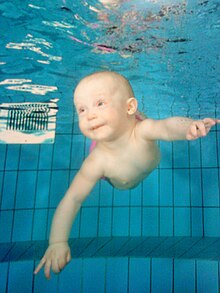Swimming - Simple English Wikipedia, the free encyclopedia


Swimming is the movement of the body through water using arms and legs. People can swim in the sea, swimming pools, rivers and lakes. People swim for exercise, for fun,[1] and as a sport. There are several styles of swimming, known as "strokes", including: front crawl, breaststroke, freestyle, butterfly, and backstroke.
Swimming works all the muscles simultaneously. It is impact free. It also builds up stamina.
Styles of swimming
[change | change source]There are several styles in swimming. Some of them are:
- Front crawl: Fastest and most efficient technique; also called freestyle, because swimmers use it in freestyle events.
- Backstroke: Only stroke that is swum on the back with the swimmer looking up; uses the same leg movements (flutter kick) as crawl.
- Breaststroke: One of the easiest and most relaxing strokes; competitive swimmers find it difficult because it uses more energy when swum at a fast pace.
- Butterfly: Powerful and fast; relies on good technique; uses the dolphin kick; the hardest and least popular stroke.
Competitive swimming
[change | change source]The goal of competitive swimming is to improve speed, and to beat other competitors in events. An athlete goes through several stages of training. At the beginning, the body is overloaded with work. The workload becomes less closer to the date of the competition. This final stage is often referred to as "shave and taper"; the swimmer tapering downs his or her workload to be able to perform at their optimal level. At the end of this stage, before competition, the swimmer shaves off all exposed hair and dead skin. Often confused within shaving, swimmers shave to rid the skin of dead skin cells to expose sensitive skin to the water. The effect of shaving is a decrease in drag from hair and an increase in the sensation of "feeling" the water.
Equipment
[change | change source]Sometimes equipment is used when swimming, and can include:
- Fins: rubber or plastic and are worn on the foot.
- Kickboard: keeps the upper body afloat; allows the swimmer to concentrate on kicking correctly
- Pull buoy: foam float that swimmers hold between their thighs to keep the lower body high and flat; helps to learn the arm and upper body movements
- Swimming Suits: These are made from a special fabric and used in swimming
Related pages
[change | change source]- Aquatic locomotion deals with animals swimming.


 French
French Deutsch
Deutsch